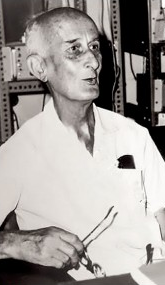Prof.Dr. Fahir Yeniçay
Fahir Yeniçay was born in 1902 in Kadıköy, Istanbul. He completed his primary and secondary education at the Saint-Joseph French High School in Moda, Kadıköy. In 1921, at just 19 years old, he was promoted to Fenerbahçe’s senior team and became an indispensable player in the defensive line. Starting his sports career in Fenerbahçe’s youth system, he played in the defense for the yellow-dark blue team from 1916 to 1924, for a total of eight years. He was a key figure in the legendary team that won the General Harrington Cup and finished the 1922–23 season as champions without conceding a single goal. Between 1921 and 1924, Yeniçay appeared in 24 official matches, wearing the jerseys of both Fenerbahçe and the Turkish National Football Team.
In 1922, he began studying Physics and Chemistry at the Faculty of Science of Istanbul Darülfünun (University). He completed his higher education in 1925. In 1927, he went to France to work on his doctoral thesis and to further his scientific knowledge. He was accepted into the Physical Chemistry and Radioactivity Laboratory at the Sorbonne University, where he worked under Nobel laureates Prof. Jean Baptiste Perrin and Marie Curie. He worked there for nearly four years on the study of “surface defects.” His thesis, “Films monomoléculaires sur l’eau et le mercure” (Monomolecular Films on Water and Mercury), was successfully defended before a jury composed of Prof. Perrin, Prof. Cotton, and Prof. Urbain. As a result, he was awarded the “Docteur d’État” (state doctorate) degree. He also received certificates in Radioactivity and Physical Chemistry.
In November 1930, he began working as a doctoral assistant at the Faculty of Science and was appointed by Prof. Cau to manage the Physics-Chemistry-Biology (PCB) laboratory. At the same time, he conducted the practical sessions for the electricity courses given by Prof. Cau to undergraduate students. In 1931, he passed the relevant examination and became an assistant professor, starting to teach atomic physics for the first time. Following the 1933 University Reform, he joined the faculty of the newly established Istanbul University as an associate professor. On October 21, 1938, he was granted the title of professor. On April 18, 1939, he was appointed dean of the Faculty of Science and held this position until 1948.
Yeniçay was among the founding members of the Turkish Mathematical Society, established in 1948. On July 4, 1949, he participated in the “Electronic-Optics” congress held in Delft, Netherlands. He also represented Turkey at a conference held in Paris between December 17–21, 1951, regarding the establishment of the European Atomic Physics Association. In 1952, he traveled to Switzerland for scientific research. From 1953 to 1955, he served as the Rector of Istanbul University.
With the growing recognition of the importance of research in atomic and nuclear physics, particularly after the publication of findings from World War II-era scientific investigations, it was proposed that a new independent chair be established within Istanbul University to focus on these fields. This initiative, begun in 1953, culminated on December 15, 1955, when Prof. Yeniçay was appointed head of the newly established Chair of Atomic and Nuclear Physics. He held this position until his retirement on July 7, 1973.
After his retirement, from September 3, 1973, to April 30, 1976, he served as director of the Çekmece Nuclear Research Center under the Atomic Energy Commission. Prof. Dr. Fahir Yeniçay passed away on Wednesday, May 11, 1988, in Istanbul and was buried in the Zincirlikuyu Cemetery.
Fahir Yeniçay made significant contributions to the development of physics in Turkey—through his own research, the studies he led, the books he wrote and translated, and the laboratories he helped establish. In recognition of his services, he was awarded the TÜBİTAK Service Award in 1972.
*This biography was compiled by our board member Özkan Değer for the booklet “TMD 75 Yılın Ardından,” prepared on the occasion of the 75th anniversary of the Turkish Mathematical Society.
